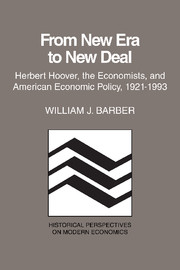Book contents
- Frontmatter
- Contents
- Preface
- Prologue: The vision of a new era in the 1920s
- 1 The ingredients of a model of a new economics
- 2 Challenges to the new economics of the 1920s
- 3 The new economics at center stage in 1929
- 4 Activating the stabilization model in late 1929 and 1930
- 5 Preliminary readings of the results of the stabilization strategy
- 6 The unraveling of the first official model in 1931
- 7 Shifting course in late 1931 and early 1932
- 8 Renewing the offensive in February and March 1932
- 9 The economists and their views on policy for 1932
- 10 Official model II as shaped in May 1932 and the aftermath
- Epilogue: Transition to the New Deal – continuities and discontinuities
- Notes
- Selected bibliography
- Index
- Frontmatter
- Contents
- Preface
- Prologue: The vision of a new era in the 1920s
- 1 The ingredients of a model of a new economics
- 2 Challenges to the new economics of the 1920s
- 3 The new economics at center stage in 1929
- 4 Activating the stabilization model in late 1929 and 1930
- 5 Preliminary readings of the results of the stabilization strategy
- 6 The unraveling of the first official model in 1931
- 7 Shifting course in late 1931 and early 1932
- 8 Renewing the offensive in February and March 1932
- 9 The economists and their views on policy for 1932
- 10 Official model II as shaped in May 1932 and the aftermath
- Epilogue: Transition to the New Deal – continuities and discontinuities
- Notes
- Selected bibliography
- Index
Summary
Scholars and statesmen have at least one characteristic in common: the projects they embark upon seldom materialize in quite the shape they anticipated. This study began as an inquiry into the way the Keynesian revolution was assimilated into the policy-making processes of the U.S. government during the presidency of Franklin D. Roosevelt. To set the stage for that discussion, an introductory chapter on the legacy of the Hoover administration to the New Deal seemed to be in order. What was originally intended to be a brief sketch of the bankruptcy of the economics of Hooverism has now become something else.
Most people below the age of sixty have been brought up to believe that the Great Depression was the watershed event of the twentieth-century history of the American economy and that all that went before is “premodern.” Certainly the generation of economists acquiring professional status since World War II has been schooled in the view that a great burst of light broke through with the publication of The General Theory of Employment, Interest and Money in 1936 and that the intellectual era preceding it was largely one of darkness (or at least of very limited vision). The manner in which we report data on the aggregative performance of the economy reinforces this impression. All of the regular publications of the statistical services of the U.S. government begin their series with 1929. By implication, the economic world before that is of no interest.
- Type
- Chapter
- Information
- From New Era to New DealHerbert Hoover, the Economists, and American Economic Policy, 1921–1933, pp. xi - xiiPublisher: Cambridge University PressPrint publication year: 1985

